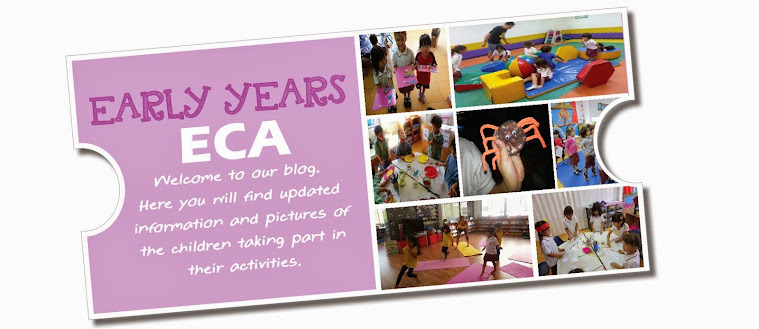Then, we practiced our eye-hand coordination by weaving strings through a leaf (with holes). The kids loved calling it their 'kite leaves' so that's what we called it! Have a look at the fun that we had!
Monday, January 25, 2016
Weaving leaf kites
Another great fine motor ECA club! The kids started off with some balancing exercises outside on the playground - we did 'follow the leader' with a twist; the leader had to walk on a line without falling. So, if the leader put his/her hands up in the air, the whole line had to do it. It was a lot of fun!
Then, we practiced our eye-hand coordination by weaving strings through a leaf (with holes). The kids loved calling it their 'kite leaves' so that's what we called it! Have a look at the fun that we had!
Then, we practiced our eye-hand coordination by weaving strings through a leaf (with holes). The kids loved calling it their 'kite leaves' so that's what we called it! Have a look at the fun that we had!
Bubble Wrap Prints and cotton sheep.
Animals are a great starting point for some fun craft activities. We made a whole flock of these cotton wool sheep and the children worked together to create the wool.
Bubble wrap is fun to explore, feeling the puffy bubble pouches and noisily popping them. After exploring, bubble wrap becomes an intriguing printing material with unusually beautiful results.
Monday, January 18, 2016
Control, balance, practice
Welcome to term 2 and our fine motor skills blog!
Fine motor skills is all about control, balance, coordination and this is something we need for everyday tasks. Developing fine motor skills can help with sports, writing, construction and even walking/running.
This is a good site for information and ideas on fine motor skills: FMS
To start off our club we did some balance exercises. The kids balanced a ball and walked in a straight line - to make it fun we made it a race! Then, we stood in a circle and worked on throwing and catching a ball. Finally, we worked on our control by making pipe cleaner necklaces. These were made into different levels of difficulty, easiest being stringing pasta and the most difficult being stringing beads. The kids did very well and produced some great items!
Fine motor skills is all about control, balance, coordination and this is something we need for everyday tasks. Developing fine motor skills can help with sports, writing, construction and even walking/running.
This is a good site for information and ideas on fine motor skills: FMS
To start off our club we did some balance exercises. The kids balanced a ball and walked in a straight line - to make it fun we made it a race! Then, we stood in a circle and worked on throwing and catching a ball. Finally, we worked on our control by making pipe cleaner necklaces. These were made into different levels of difficulty, easiest being stringing pasta and the most difficult being stringing beads. The kids did very well and produced some great items!
Texture painting!!
For our painting session we decided to try combining some kitchen ingredients into paint for free exploration and to see what effect each would have on the texture created. Into some bowls we collected salt, flour, glitter and white glue. We could also have used sawdust, glitter, soil, sand, crushed cereal, shredded paper, shampoo etc. and perhaps we will next time we try this!
The paints were wonderfully tactile to touch, stir and paint with and each material was quite different in the effect it produced. They adhered to the paper in a very satisfying way and I imagine they would work well with recycled cardboard materials if making a textured paint sculpture too.
Running our fingers over the surface when they were dry felt lovely and gave some opportunities for some rich, descriptive language.
Subscribe to:
Posts (Atom)
























































